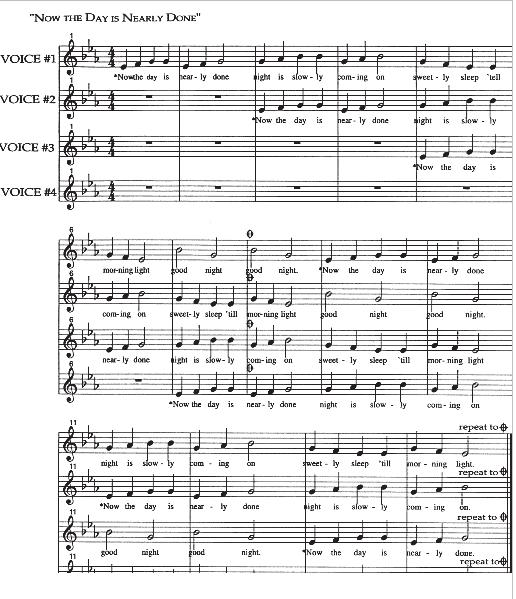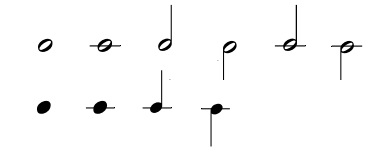
CHAPTER 2: FINDING YOUR PART AND FOLLOWING THE NOTATION
Most choral music combines more than one musical part or voice. The musical composition on the following page is a round entitled, Now the Day is Nearly Done.
The song is a lullaby.
Now the day is nearly done,
Night is slowly coming on.
Sweetly sleep till morning light.
Good night, good night.
Because this composition is a round in four parts, the chorus first divides into four different groups. The first voice begins the song, and then the second group enters with the same melody. By this time, the first voice is further along in the song, and the first two voices overlap and sing different parts of the song at the same time. The third voice then enters overlapping the first two, then the fourth and final voice enters, and all four voices are heard simultaneously. A round is composed so that the musical tones of the different voices overlap in a beautiful way.
Notice that the text was sung smoothly and "sweetly," as if to comfort and calm a small child at bedtime. Two questions that constantly present themselves to singers are, "What is being expressed in the text?" and "How can you express these thoughts or feelings with your singing?"
By looking at notation below, you can see how the texture gradually gets thicker, until all four parts are singing different parts of the song at the same time. Hearing a round performed is like watching a pencil drawing being expanded to three dimensions and filled in with color.
FIG. 1

This composition is a simple example of polyphony, which is, quite simply, the art of combining more than one voice. In order to find your part in this type of composition, you only need to find which number you have been assigned, VOICE #1, 2, 3 or 4. If the round is presented as it was on the previous page, you can follow the words of the different voices and discover when your part comes in.
In Fig. 2 below, VOICE #1 is presented in its entirety. The music notation is translated into a drawn line labeled GRAPHIC, which ascends, descends, or stays at the same level, reflecting the motion of the hollow or filled-in dots‒the noteheads‒of the music notation.
Noteheads are ovals that are either hollow or filled-in. Noteheads can either have a line through them or have no such line. Noteheads can have a line attached to them‒a stem‒or have no such line. For now, notice how the noteheads move up, move down, or stay at the same level, and trust that you will understand the function of the stem later8.

Examples of noteheads
Both FIG. 2 and the graphic notation below tell your voice what to do‒when to go up, when to go down, and when to stay at the same level. Again, follow the ovals and disregard the stems for now.
FIG. 2

The technique of using one voice to imitate another voice exactly is only one of many ways of combining voices. The example presented in Fig. 3 below is more complex. Although the chorus is again divided into four parts, each part sings a slightly different melody.
FIG. 3

In order to perform this composition, you need to find your own part, and to accomplish this you need to determine your own voice classification and discover where that part is found in the musical score. Your voice classification reflects the musical range or register in which your voice sounds best: low, medium, or high. The basic information about the voice parts is presented below.
WOMEN'S VOICE PARTS9
soprano: For the highest female voices; sometimes divided into first soprano (higher) and second soprano (lower) sections.
alto: For the lower female voices; sometimes divided into first alto (higher) and second alto (lower) sections; the full name for this voice is contralto.
MEN'S VOICE PARTS
tenor: For the higher male voices; sometimes divided into first tenor (higher) and second tenor (lower) sections; this part can also be sung effectively by altos.
bass: For the lowest male voice; sometimes divided into first bass (higher) and second bass (lower) sections.
If, for example, you have been classified as a tenor, you must find and sing the tenor part, which is the third staff down from the top and is marked as such.

If you sang this part along with the rest of the tenor section, you would understand that the melody of your part corresponds with the graphic shape of the musical notes which accompany the words: the noteheads of your part either stay at the same level, or they go up or down, and they direct you and the other singers in your section to do the same with your voices.
This sounds like an over-simplification, but it is precisely what the notational system is designed to do: provide singers (and instrumentalists) with a design that correlates exactly with the contour of the melody, which goes up or down or stays at the same level. Once you learn to interpret this design, you will be able to read the notation, and once you can read the notation, you can convert it into the amazing phenomenon called music: from sight to sound!
If you can find your vocal part and can follow the basic contour of the noteheads of the notation while singing the text, you are already reading music at the level of many amateur chorus members. Although you are already functioning at a relatively high level, you are probably dependent on your section. That is, you can sing along with a group of people who know how to read music, or who know the music intimately, but you would have difficulty singing the same part all by yourself. My goal is to help you become more independent by helping you acquire new music reading skills.